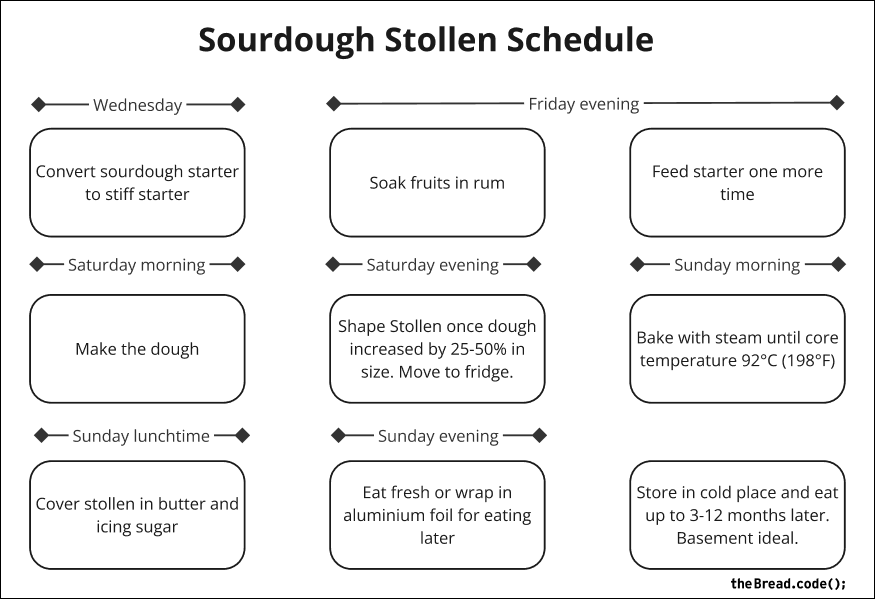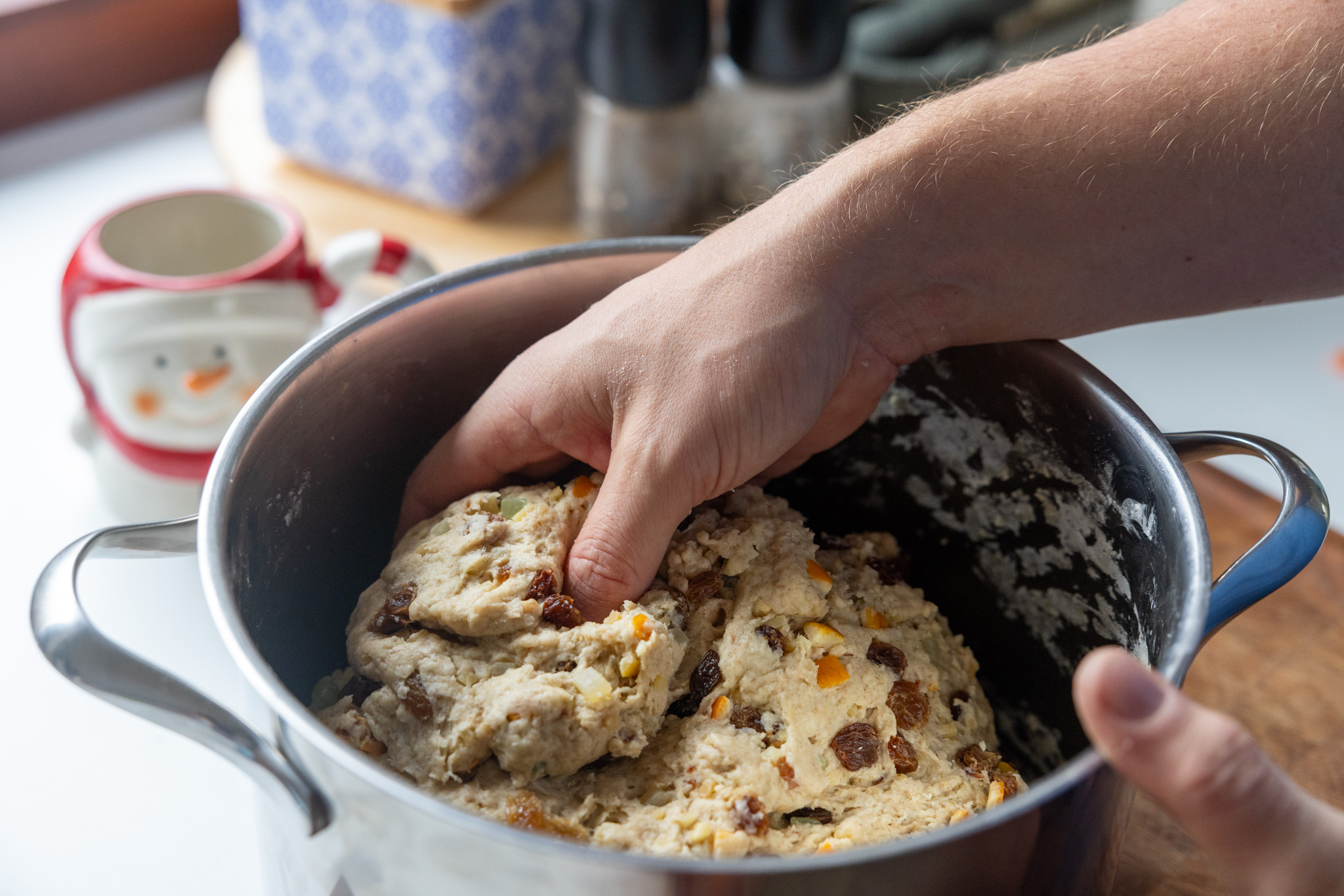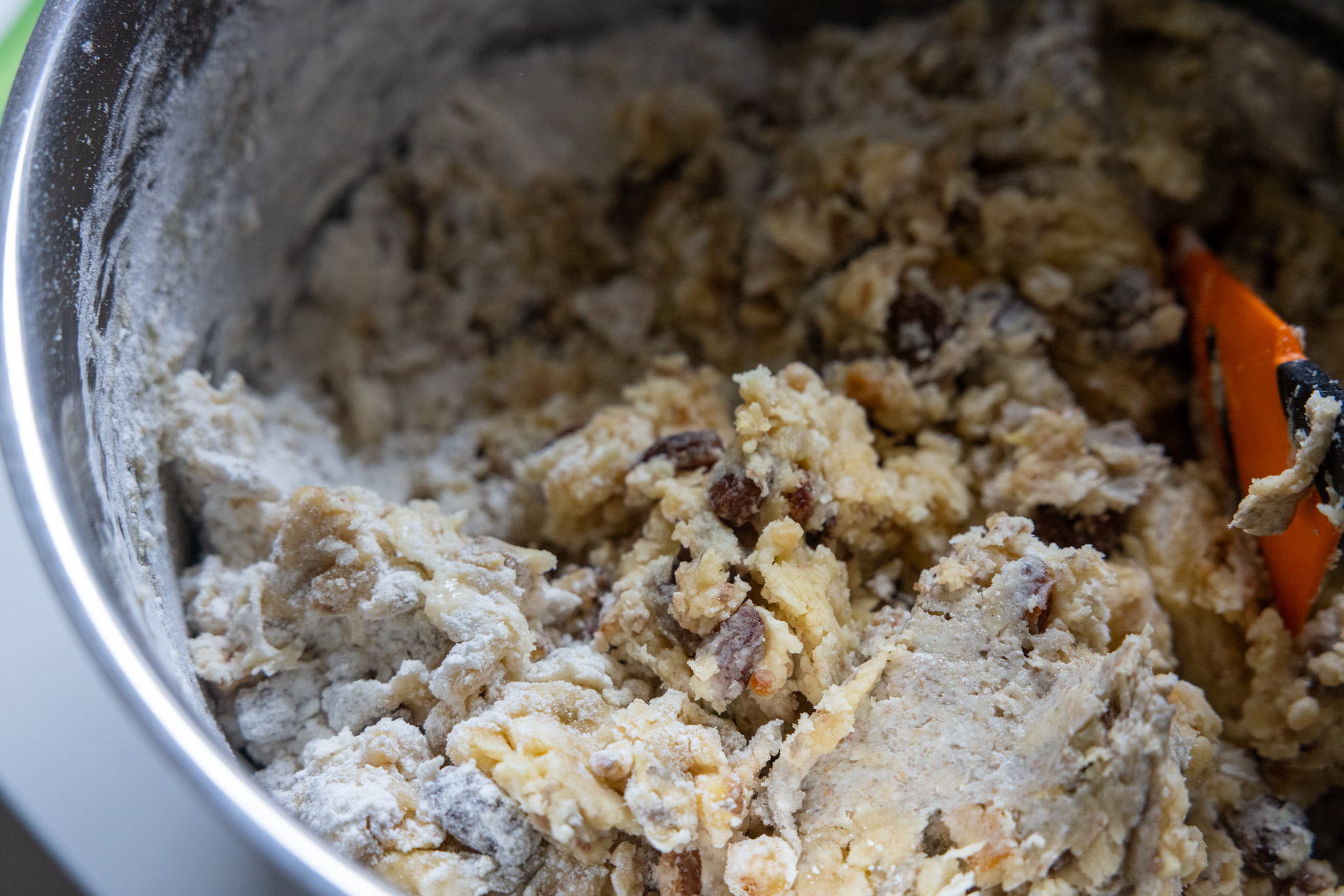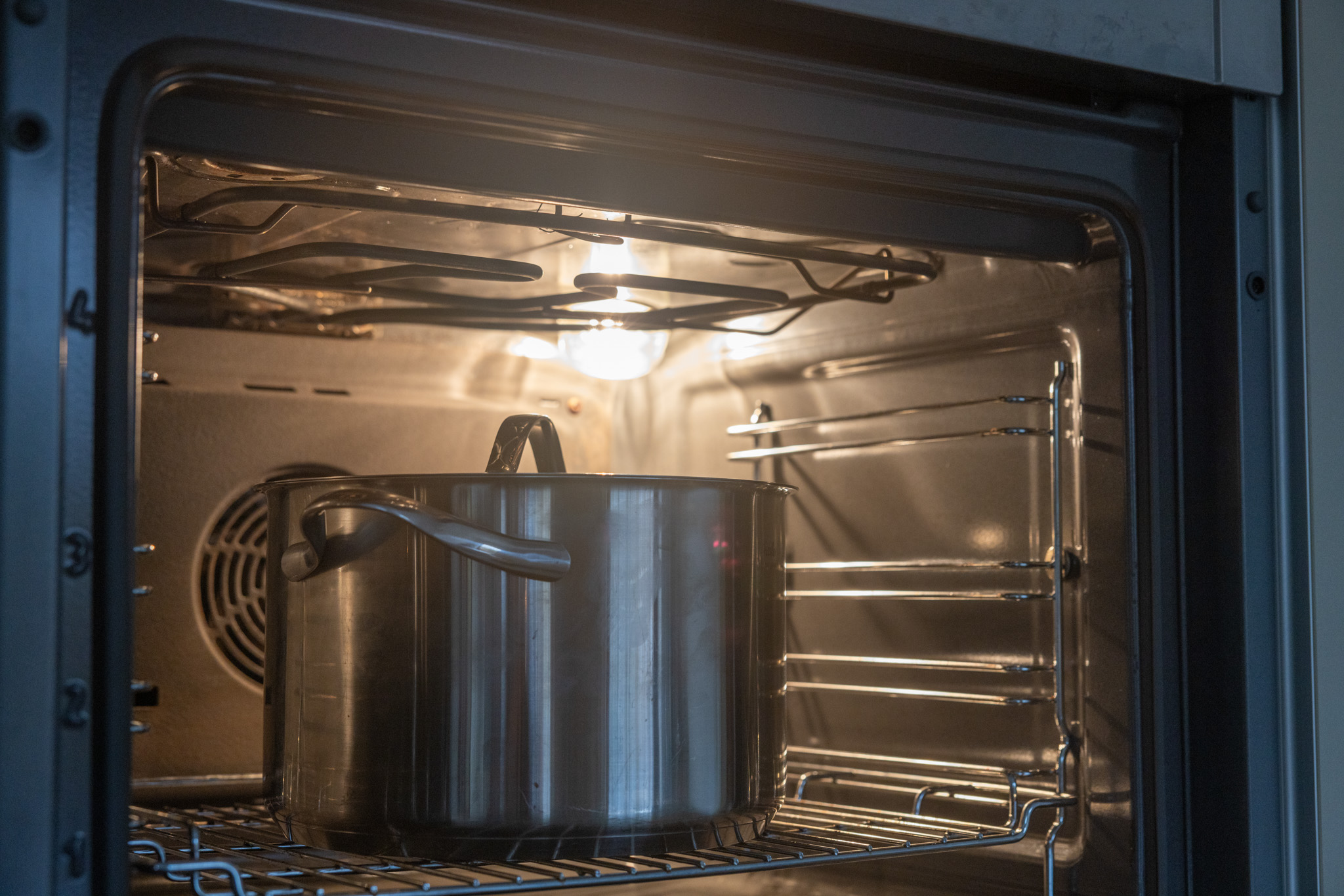World's best Sourdough Stollen (traditional recipe)
Stollen is a traditional German recipe typically served for special occasions such as Christmas. Unfortunately, over the years, yeast has replaced traditional sourdough-based recipes. That’s why I decided to go back in time and put together a traditional recipe, the way my German ancestors probably made it. The result is a mind-blowing Sourdough Stollen that is unbeatable in terms of flavor.
The process
This is just a small flowchart with example timings to visualize the whole process from start to finish. The recipe assumes that you have created your sourdough starter in advance. Begin on Friday evening and finish on Sunday. You can adapt the timings to fit your own schedule.
Preparing your starter
You will want to have a mild sourdough starter that does not produce much acidity. For that, I recommend making a stiff sourdough starter. It’s basically a starter with 50% hydration. This means for 100g of flour, it has 50g of water. In Italy, this is known as a Lievito Madre. Traditionally, they are made with fruit water, which you don’t have to do. Instead, take your regular sourdough starter and then feed it with 10g of your existing starter, 50g of flour, and 25g of water. Repeat this process at least twice. So use some of the starter you just made, feed it one more time etc.. This way your starter’s microorganisms will begin to adapt.
You will have a starter with much more yeast activity and less bacterial activity. If your sourdough starter is very acetic and smells like vinegar initially, consider converting it to a liquid starter in advance. This will change your microorganisms to produce more dairy notes. It’s mindblowing if you ask me how just changing the water percentage can completely change your sourdough starter.
In case you were wondering, it’s stiff because it holds together. If you flip your jar over like this, it just stays in the jar! Magic. You can read more about different starter types in this article.
Now this recipe calls for 200g of stiff starter in total. That means that the day before you want to make the dough, feed your starter one more time. This time take around 15g of the stiff starter you made, mix with 150g of flour and 75g of water. You’ll end up with a bit more than 200g of starter. Keep the left-over starter for your next dough.
Recipe for 2 Stollen
You will need to use 1000g of bread flour to make 2 Stollen. I am providing baker’s math percentages, this way you can scale up or down your production. If you want to make 10 Stollen, just use 5kg of flour then recalculate the percentages.
Drunken fruits
We will be making a drunken fruit mixture by letting fruits soak in rum for some time. If you don’t like raisins, you can skip them. Every fruit that you like will work. To make an authentic Dresdner Stollen raisins are required. Prepare the mixture overnight and let the mixture soak up the rum.
Integral part of the mixture is candied orange and candied lemon peel. In more ancient times citrus fruits were rare in Germany. To make them durable they were candied. The sugar creates a lot of osmotic pressure, making it almost impossible for microorganisms to enter. That’s also why jam for instance stays good for a very long time.
And this is the candied orange peel:
Use a dark rum for this. This will help to enhance the flavor of your final Stollen. I like something that has been stored in wooden barrels for some time, inducing nice tannins into your dough. Use as much rum as required to properly soak the fruits. In my case, I used around 300g of rum for them to be covered in the rum.
| Ingredient | Weight in grams | Baker's math | Comment |
|---|---|---|---|
| Raisins | 350 grams | 35.00% | |
| Dark rum | 300 grams | 30.00% | Use as much as you need to cover the fruits |
| Candied lemon peel | 100 grams | 10.00% | |
| Candied orange peel | 100 grams | 10.00% | |
| Almonds | 100 grams | 10.00% | |
| Lemon zest | 1 grams | 0.10% |
Let the mixture soak at least 8 hours. Ideally, you also fed your sourdough starter one last time in the evening. This means we can proceed with making the actual dough in the morning after waking up.
In the morning take your drunken fruits and let them rinse for around 30 minutes so that the excess rum is able to drip down from the mix. I like to use the left-over rum for another batch of Stollen.
Preparing the Stollen Dough
Now it’s time to make the actual dough for your Stollen. This is what you will need:
| Ingredient | Weight in grams | Baker's math | Comment |
|---|---|---|---|
| Bread flour | 1000 grams | 100.00% | Alternatively you can use all purpose or cake flour. |
| Room temperature milk | 175 grams | 17.50% | Add slowly to see consistency of dough. Dough should be like playdough. Add more milk if needed. |
| Stiff sourdough starter | 200 grams | 20.00% | |
| Unsalted melted butter | 250 grams | 25.00% | |
| Eggs size m | 120 grams | 12.00% | |
| Sugar | 100 grams | 10.00% | |
| Vanilla extract | 2 grams | 0.20% | |
| Salt | 10 grams | 1.00% | |
| Cinnamon | 2 grams | 0.20% | |
| Cardamon | 1 grams | 0.10% | |
| Nutmeg | 1 grams | 0.10% |
After the bake you will need a few more ingredients, just adding them here already:
Ingredients for the Stollen glaze after the bake:
| Ingredient | Weight in grams | Baker's math |
|---|---|---|
| Unsalted butter | 100 grams | 10.00% |
| Powdered Sugar | 400 grams | 40.00% |
Incorporate all ingredients and knead by hand for 5 minutes until you see that there are no chunks of flour left and that everything has been properly incorporated into the dough. I recommend kneading by hand so that you develop a better feeling for the dough’s consistency. There’s no need to do excessive kneading as you’d do when making bread. It’s merely about making sure that all the ingredients have been nicely homogenized.
If the dough is too dry you can add more milk. Add the milk slowly in batches of 20ish grams. Mix a bit more and wait. If you overdid the milk, add a bit more flour.
If you knead in a stand-mixer I recommend kneading the dough for 5 minutes and then add the fruits later. You don’t want them to tear by the mixer.
The consistency of the dough is important, it should be like playdough.
It should be drier rather than too wet. The soaked fruits will release
additional moisture into the dough later.
Round up your dough and move it to a container. I like to use a stainless steel pot with a lid.
Overall this is how your dough should look like after mixing.
Bulk Fermentation
We are fermenting all our Stollen doughs together in bulk. Your dough should increase by 25% in size, then you are ready to proceed. Because you added a lot of butter to the dough and the rum, the fermentation is slow. In my case I made the dough at around 9am and then my dough was ready at around 6pm. It will take around 8-14 hours depending on your sourdough starter’s activity and the ambient temperature. To speed things up you can move your dough to a warm place in your home. Another good hack is to place it in the oven with the oven light on.
If your dough isn’t ready until evening time you can move the dough to the fridge and let it continue to ferment at room temperature the next day.
Dividing and preshaping
Split your dough into equally sized chunks. Don’t press the dough dough too much, make rectangles out of your dough. Gently round the edges. Let your doughs sit for 5 minutes.
Shaping
Place some flour on your surface. With a dough scraper loosen the dough from the surface. Take the dough and place it on your floured surface. Imagine your dough is divided into 4 equally sized imaginary lines with the first line on the edge. Lift the dough and carefully fold it over onto the third line. This is what your dough should look like then:
Proofing
Cover your dough with a wet towel and let your dough sit for another 30 minutes. In the meantime preheat your oven to 180°C (350°F).
Baking
Take your Stollen and place it on a rack with parchment paper. Spray your Stollen generously with water. We don’t want the Stollen to dry out too quickly in the oven. Place another tray on top of your Stollen. This simulates a dutch oven and makes sure that we have a very steamy environment. This really is a game changer for everything you are baking in your home oven. You can read more about baking and my default oven setup here.
Don’t use the fan of your oven. You don’t want to fan out the steam. We want to steam the Stollen as much as possible. The more steam the better, we do not want any crust to be developed. If you can not turn off the fan in your oven spritz your stollen with water every 20 minutes. Furthermore consider reducing the temperature a bit.
Your Stollen is ready the moment the core temperature reaches around 92°C (197°F). This is best measured with a thermometer. In my case, that was after roughly 60 minutes.
Post-Bake
Heat the butter for the glaze and directly generously rub the Stollen with butter.
Place your Stollen on a cooling rack. Once the Stollen has cooled (60 minutes later). Generously rub your Stollen again with butter. Then proceed and cover your Stollen in powdered sugar. Make sure to not miss any spots. This is very important! I like to use a large bowl where I toss the Stollen and the sugar inside. Makes things easier.
The layer of sugar prevents pathogens from entering your Stollen. It’s better to use more than too little powdered sugar here.
Wrap your Stollen in Aluminum foil and then store it in a Ziploc bag, ideally something that’s airtight. This way humidity builds up which makes the Stollen stay nice and wet. It won’t mold because of the powdered sugar and the slight acidity coming from the sourdough starter. The Alu-foil helps to deflect light. So in combination with the sugar you have the perfect storage maturing chamber.
Ideally, let the Stollen sit at least for 1 day before tasting it. This allows the fruits to release more Aroma into the dough. It’s popular in Germany to leave one Stollen until Eastern. This would be an “Osterstollen”. It can stay good for a very long time! Most Germans store it for at least a week before tasting it. But seriously, the next day it already tastes much better than most Stollen you can find. I was so amazed and so happy this could be made to work with Sourdough.
The below picture shows the perfect consistency of the Stollen. Slightly fluffy, but not too much.
Over time the dried fruits will release more Aroma into the Stollen. That’s why it should mature.
Storage
Ideally store the Stollen in a place where it’s a bit colder (5-15°C, 40°F - 60°F). This way your Stollen can mature without turning bad. Some people store it for several months like this.
Updates
9th December 2024 - simplify a few steps, add more details on how to feed the starter.























